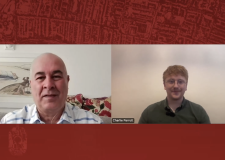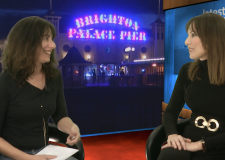The Brighton brand
An online prospectus is being created to try to bring more businesses and jobs to our city. Frank le Duc reports
Brighton is many things to many people; the home of the dirty weekend, the hen capital of Britain (not forgetting the stags) and the drug death capital – it’s a gay-friendly easy-going party-loving kind of town. We’ve got Pride, foreign language students chattering on buses and bustling in Churchill Square, as well as thousands of university students too. It’s Brighton breezy, youthful and fun. It’s quirky, independent and rather bohemian.
There’s a serious side too. Brighton’s eco-friendly. After all, we’ve got a Green council and a Green MP, although it may not pay to look too closely at our record as opposed to our reputation. The Greens, of course, want to improve our record on recycling and our approach to the environment and sustainable living. Brighton’s also arty and creative. It’s enterprising, with hundreds of business start-ups. The digital and new media sectors are well-represented here.
The Royal Pavilion and the Dome, our Regency heritage and seafront squares all form part of our brand. So does the pier, well so do both our piers. Yes, we know the parking’s a nightmare and so do many of the millions of visitors who come here every year. It’s not unknown for developers to grumble. There’s a familiar litany of projects, thwarted or stalled, but it’s gradually being displaced by a growing list of sites where progress has been made.
The progress is being charted in a ‘city prospectus’, a brochure if you prefer. But this is not some kind of pamphlet targeting tourists and day-trippers. It’s geared towards the big-hitters of the business world – not just those in property, although land and buildings have a crucial place in all this.
WHAT MAKES BRIGHTON SPECIAL
We can expect to see the first public version of the online city prospectus in the coming month or so. The work has been taking place quietly behind the scenes as politicians, officials, business leaders and consultants try to define exactly what it is that Brighton has to offer, what makes Brighton special, what deters firms from doing business here and what we need to do and say to attract inward investment.
All this matters because we need to create jobs. One expert said last year that we need to create 6,000 in only a few years just to stand still. The coming bulge in school leavers and graduates will exacerbate the need. And the need arises at a time when the economy is (we hope) emerging from recession. Forecasts and government announcements suggest that the public sector will shrink. Again, this makes the need to create jobs more pressing. Some believe that too many of the jobs being taken at the moment are part-time, poorly paid and fragile.
Those behind the city prospectus might be seen as defining the Brighton brand. It’s not a phrase they seem keen to use. One of them, Tony Mernagh, chairman of the Brighton & Hove Economic Partnership, said: “We would be on a bit of a hiding to nothing if we were trying to create a brand for Brighton, we’re so many things. This is not an attempt to define Brighton as a brand. If we were going there, nobody would be satisfied.
“The prospectus is about creating an online presence to promote Brighton and Hove to the UK and international investors. It’s the entrepreneurial capital of the UK. The prospectus is about saying: ‘Here are the city’s assets. Here are the key factors in terms of skills and education and employment. Here are the opportunities, and not only do we talk a good game, but here are some examples of investment successes.’
“We’ll be giving information about innovation and business incubation and links with our two outstanding universities. And transport links – both inter-city and intra-city, as well as global. Investors want to know how close is it to Heathrow, Gatwick and the Channel Tunnel – how quickly can they get to market.”
A CITY OF OPPORTUNITIES
There are three pillars supporting the prospectus – opportunities, the universities and “Brighton the place”. Big employers want to know about the demography of the towns and cities where they are based and about the economic profile. The workforce and their skills are crucial. The prospectus talks about Brighton and Hove as a young and growing city – and an international city at that. Case studies underline Brighton’s entrepreneurial spirit, highlighting the likes of Steve Rayson. The former council officer set up e-learning company Kineo seven years ago and now employs hundreds of staff around the world.
Mr Mernagh said that the universities (Sussex and Brighton) turned out world-leading research and had a track record of turning innovation into business success. He said that the prospectus talked about the public and private education that’s available in and around Brighton and Hove. For some, Roedean and Brighton College might spring to mind. But there are dozens of private language schools and 35,000 multilingual international students in the city. The language schools, such as Study Group International, are worth more than £100 million a year to the city.
“Brighton the place” is a dynamic, international, compact city with a fantastic cultural offer and world-class landmarks. Between the South Downs and the sea are the Royal Pavilion, the Dome, the Palace Pier and Regency architecture. The Brighton Festival attracts performers and punters from around the world and Glyndebourne is among the many offerings right on the doorstep.
A local online marketing firm, GSB Associates, has been given the job of coming up with a website that has the right look, feel and functionality. Another local consultancy, This Is Regeneration Ltd, is writing the content. Much of the credit for the whole idea belongs to Geoff Raw, the council’s strategic director.
Three important tests are in the pipeline; one is a visit in November by a group from UK Trade and Investment (UKTI), which promotes Britain and British business around the world. They are a key point of contact in our embassies abroad when big international firms want to open an office or factory here. Another key is whether Brighton and Hove is chosen as the ‘future cities demonstrator’, a decision worth up to £24 million. The application has to be in by mid-November. A positive outcome will help underwrite the Greens’ One Planet Living policy.
The third test is whether Brighton and Hove is made one of Britain’s so-called second-tier cities. The government has given extra money and freedom to eight core cities outside London, including Birmingham, Liverpool and Manchester. If Brighton and Hove is included in the next tier, it will have a better chance of competing for investment and jobs.
So although there is a reluctance to talk about the Brighton brand, it is clear that the key selling points are being pulled together. The Economic Partnership is stepping up, supported by the council and the Chamber of Commerce and others, to showcase the best of Brighton and Hove. We have barely half a dozen big private sector employers, such as American Express or Legal and General and while we cherish our many independent traders, luring a big employer to Brighton would provide a timely boost for jobs.




















